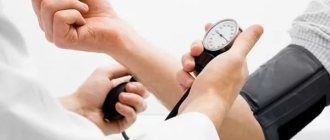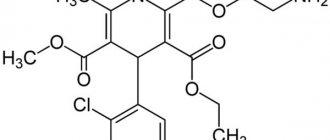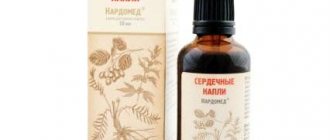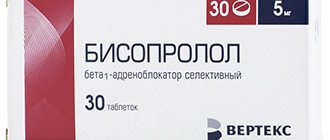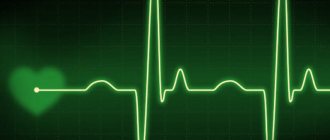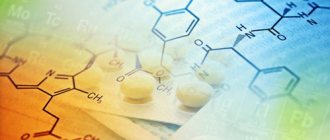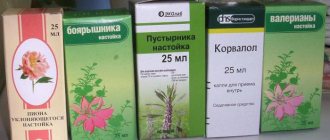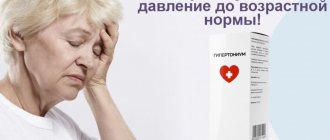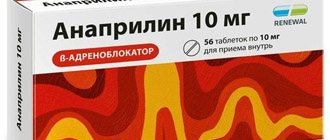Make an appointment by phone: +7 (343) 355-56-57
+7
- About the disease
- Cost of services
- Sign up
- About the disease
- Prices
- Sign up
What is sinus bradycardia.
This is a decrease in the heart rate emanating from the sinus node to less than 60 per minute.
In every person, deep in the heart muscle (myocardium) there is a so-called conduction system. It is a network of thin nerve fibers that conduct impulses through the myocardium and it is precisely this that causes the human heart to beat at one frequency or another.
The principle of its operation is reminiscent of electrical wiring - there is an initiator of an electrical impulse (the sinus node itself) and there are elements that conduct impulses from it. If “problems” occur at one of the stages of the impulse, arrhythmias develop.
In the case of sinus bradycardia, the frequency of impulses emanating from the sinus node itself decreases to less than 60 beats per minute.
Sinus bradycardia can be either physiological (normal)
, and
pathological
, that is, associated with any diseases or health conditions.
What are Zelenin drops?
The drug was developed by a Russian scientist, Doctor of Science and Honored Worker of Medicine - Zelenin V.F. Based on many years of research, he created a drug with combined action. The drops are a herbal medicine that eliminates spasms, reduces nervous excitement and stimulates the heart.
The product is available in glass bottles with droppers, which makes administration especially convenient. The liquid has a clear, slightly brown color and a bright smell of herbal infusions. Bottles with capacities from 15 to 40 ml are available.
Zelenin drops are used for bradycardia and other cardiac neuroses, as well as for such disorders as:
- Gastrointestinal spasms;
- VSD;
- Renal or hepatic colic;
- Chronic cholecystitis;
- Increased excitability and irritability;
- Hyperacid gastritis;
- Diseases of the biliary tract;
- Decreased appetite.
Only a doctor should prescribe drops; you should not self-medicate; despite the apparent harmlessness of the medicine, the patient risks complications without proper medical supervision.
The drug has a calming and antispasmodic effect; it helps restore heart rate due to a complex of herbal components.
Bradycardia. Real danger?
Bradycardia is a slowing of the heart rate (HR) due to decreased sinus node function. With bradycardia, the cells of the first order pacemaker, the sinus node, are affected.
The causes of bradycardia may be an imbalance with increased activity of the parasympathetic autonomic nervous system and organic irreversible damage to the heart.
The pacemaker cells of the sinus node produce 60–80 impulses per minute. The lower limit of the normal frequency of sinus rhythm is considered to be 60 per minute. Nearly 25% of healthy young men have a resting heart rate between 50 and 60 bpm. A decrease in heart rate to values less than 15% serves as another criterion for bradycardia.
Bradycardia is divided according to clinical and pathogenetic principles.
Classification of bradycardia:
- neurogenic (vagal);
- endocrine;
- toxic;
- medicinal;
- myogenic (organic);
- constitutional-family.
The neurogenic (vagal) form is represented by various variants and accompanies: neuroses with vagotonia, vagoinsular crises, increased intracranial pressure, subarachnoid bleeding, labyrinthitis, peptic ulcer, sliding hiatal-diaphragmatic hernia, renal, hepatic, intestinal colic, acute diffuse glomerulonephritis, acute period of lower myocardial infarction (Bezold-Jarisch reflex), convalescence after severe infectious diseases.
Vagal bradycardia is often combined with severe sinus arrhythmia.
Endocrine bradycardia is most often associated with decreased function of the thyroid gland and adrenal cortex.
Toxic (endogenous or exogenous) bradycardia accompanies severe states of intoxication (uremia, liver failure). This group includes bradycardia against the background of severe hyperkalemia or hypercalcemia.
Drug-induced bradycardia occurs with the use of beta-blockers, non-dihydropyridine calcium antagonists (verapamil, diltiazem), centrally acting antihypertensives (clonidine, moxonidine), antiarrhythmics (amiodarone), cardiac glycosides, and opiates.
Particular difficulties arise when assessing bradycardia in athletes. In trained athletes (runners, swimmers, skiers), the resting heart rate can slow down to 30–35 per minute. Bradycardia of athletes reflects the optimal level of neurovegetative regulation of the heart outside the period of exercise, a relative decrease in sympathetic tone with an increase in the tone of the vagus nerve. Detection of bradycardia in people involved in sports requires the exclusion of organic heart pathology.
Constitutional familial bradycardia is inherited in an autosomal dominant manner. It is distinguished by the stability of autonomic imbalance with a predominance of vagus nerve tone.
The myogenic (organic) form of bradycardia is associated with cardiac diseases such as hypertrophic cardiomyopathy and primary pulmonary hypertension [1]. Bradycardia can serve as the first manifestation of such a life-threatening disease as sick sinus syndrome (SSNS, sinus node dysfunction).
SSSS is based on degenerative changes, the development of which depends on genetic predisposition, neurovegetative changes, and sensitivity to various damaging factors.
In most cases, sinus bradycardia and SSSS reflect different degrees of severity of disturbances in pacemaker activity and are different stages of a single pathological process. Bradycardia in SSSS can be detected incidentally or during examination for fainting. Without treatment, the disease progresses and dysfunction of the sinus node increases.
SSSS is a clinical electrocardiographic syndrome that reflects structural damage to the sinoatrial node as the first-order pacemaker of the heart, ensuring the regular conduction of automatic impulses to the atria. SSSU include:
- severe sinus bradycardia <40 beats per minute;
- minimum heart rate during the day < 40 per minute, determined by ECG monitoring, and its increase during physical activity, not exceeding 90 minutes;
- bradysystolic variant of atrial fibrillation;
- atrial pacemaker migration;
- stopping the sinus node and replacing it with other ectopic rhythms;
- sinoauricular block;
- pauses > 2.5 s resulting from sinus node arrest, sinoauricular block, or rare escape rhythms;
- tachy-brady syndrome (alternating periods of tachycardia and bradycardia);
- slow and unstable restoration of sinus node function after extrasystoles, paroxysms of tachycardia and fibrillation, as well as at the moment of termination of stimulation during an electrophysiological study of the heart > 1600 ms;
- inadequate reduction in rhythm when using small doses of beta-blockers. Presence of bradycardia during the administration of atropine and exercise testing.
SSSU is divided into primary or secondary.
Primary SSSS includes dysfunction caused by organic lesions of the sinoauricular zone with: coronary heart disease, hypertension, hypertrophic cardiomyopathy, heart defects, myocarditis, hypothyroidism, dystrophy of the musculoskeletal system, amyloidosis, sarcoidosis, etc.
Secondary SSSS occurs when the sinus node is exposed to external factors: hyperkalemia, hypercalcemia, treatment with β-blockers, amiodarone, verapamil, digoxin, etc.
Among the causes of bradycardia are autonomic sinus node dysfunction (ASD), which is observed with hyperactivation of the vagus nerve [2]. The diagnostic criteria for SSSU and VDSU are presented in Table.
The clinical manifestation of SSSS can be different. In the early stages, the course of the disease may be asymptomatic even if there are pauses of more than 4 s.
Patients with mild symptoms may complain of feeling tired, irritability, emotional lability and forgetfulness. As the disease progresses and blood circulation is further impaired, cerebral symptoms become more pronounced (the appearance or intensification of dizziness, momentary memory loss, paresis, “swallowing” of words, insomnia, memory loss).
As the disease progresses, symptoms associated with bradycardia are noted. The most common complaints include a feeling of dizziness, severe weakness, even fainting (Morgagni-Adams-Stokes syndrome). Fainting of a cardiac nature is characterized by the absence of an aura and convulsions.
Based on the characteristics of clinical manifestations, the following forms of SSSU are distinguished:
1. Latent form - absence of clinical and ECG manifestations.
Sinus node dysfunction is determined by electrophysiological study. There are no work restrictions. Implantation of an electrical pacemaker (pacemaker) is not indicated.
2. Compensated form: mild clinical manifestations, complaints of dizziness and weakness, there are changes on the ECG:
a) bradysystolic variant, pacemaker implantation is not indicated; b) brady/tachysystolic variant, pacemaker implantation is indicated in cases of CVS decompensation under the influence of antiarrhythmic therapy.
3. Decompensated form:
a) bradysystolic variant - persistently pronounced sinus bradycardia is determined, manifested by impaired cerebral blood flow (dizziness, fainting, transient paresis), heart failure. Significant limitation of ability to work. Indications for implantation are asystole and VVFSU more than 3000 ms; b) brady/tachysystolic variant - paroxysmal tachyarrhythmias (supraventricular tachycardia, atrial fibrillation) are added to the symptoms of the bradysystolic variant of the decompensated form. The patients are completely disabled. The indications for pacemaker implantation are the same [3, 4].
At the beginning of SSS therapy, all drugs that may affect the function of the sinus node are discontinued. In the future, it is possible to use metabolic therapy with unproven effectiveness, prescribed long-term for 3-6 months in continuous sequential courses:
- antioxidant and cardioprotective effects (Mexidol, coenzyme Q10, etc.);
- improving energy metabolism in the myocardium (creatine phosphate, Actovegin, Mildronate, L-Carnitine, trimetazidine, etc.);
- nootropic action (piracetam, gamma-aminobutyric acid, hopantenic acid, pyritinol, etc.);
- vitamin complexes.
With the progression of sinus node disorders, it may be necessary to install a pacemaker, which improves the quality of life, but does not increase its duration, which is determined by the nature and severity of concomitant organic heart disease [5].
Absolute indications for pacemaker implantation:
- history of Morgagni–Adams–Stokes attacks (at least once);
- severe bradycardia (less than 40 bpm and/or pauses of more than 3 s;
- VVFSU more than 3500 ms, corrected VVFSU - more than 2300 ms;
- the presence of dizziness caused by bradycardia, presyncope, coronary insufficiency, heart failure, high systolic arterial hypertension, regardless of heart rate;
- SSSU with rhythm disturbances requiring the prescription of antiarrhythmic drugs.
The sinus node is a complexly organized multifunctional system. Sinus bradycardia can serve as the first symptom of a progressive degenerative process in the heart muscle. Timely examination makes it possible to identify patients at risk for the development of progressive dysfunction of the sinus node for timely installation of pacemaker.
Literature
- Strutynsky A.V. Tachyarrhythmias and bradyarrhythmias: diagnosis and treatment. M.: MEDpress-inform, 2013. 288 p.
- Ardashev A.V., Dzhandzhgava A.O., Zhelyakov E.G., Kuznetsov Yu.V., Voloshko S.V. Clinical effectiveness of permanent cardiac pacing in patients with bradysystolic forms of cardiac arrhythmia and conduction disorders // Cardiology. 2008. No. 1. P. 51–56.
- Sayfutdinov R. G., Pak E. V., Garipova A. F., Gilyazova A. R., Gabitov S. Z., Rubanova E. F., Nasybullina R. S. Sick sinus syndrome in the practice of a cardiologist // Bulletin modern clinical medicine. 2010. T. 3, issue. 2. pp. 55–63.
- Janashia P. Kh., Shevchenko N. M., Janashia N. D. Sick sinus syndrome // Heart. 2009. T. 1, No. 2. P. 97–99.
- Bokeria L. A., Revishvili A. Sh., Golitsyn S. P., Egorov D. F., Sulimov V. A. Clinical recommendations for electrophysiological studies, catheter ablation and the use of implantable antiarrhythmic devices. GEOTAR-Media, 2013. 596 p.
G. I. Nechaeva1, Doctor of Medical Sciences, Professor T. V. Tkachenko, Candidate of Medical Sciences S. F. Gunter
State Budgetary Educational Institution of Higher Professional Education Omsk State Medical Academy of the Ministry of Health of the Russian Federation, Omsk
1 Contact information
Composition and pharmacological action
The product has shown its effectiveness in the fight against heart pathologies, due to its unique natural composition, which includes:
- Belladonna leaves - reduce the level of secretion of the pancreas and salivary gland, improve the conductivity of electrical impulses in the muscles, reduce the appearance of spasms;
- Lily of the valley leaves are a cardiotonic product, significantly increase the speed and frequency of contraction of the heart muscle, help get rid of bradycardia;
- Valerian officinalis roots have a sedative effect, help improve sleep and reduce excitability. The result is not immediately noticeable, which allows you to avoid negative consequences for the body. Valerian dilates coronary vessels, affects the myocardial muscle, restores the conductive function of the heart;
- Menthol is an auxiliary component that improves organ reflexes, including helping muscles contract. It is a local irritant, tones the veins, relieves pain, and has an active effect on the heart.
It is the natural composition that ensures the high effectiveness of the product and the almost complete absence of side effects.
Diagnosis of sinus bradycardia
It is carried out by recording an ECG and Holter ECG monitoring throughout the day.
Diagnosing sinus bradycardia is not easy. Additional examination may be required - echocardiography (ultrasound of the heart), examination of the abdominal organs, thyroid gland, etc. A cardiologist and arrhythmologist will help the patient with this.
Our clinic “New Hospital” offers examinations necessary for a full diagnosis and selection of the correct tactics for sinus bradycardia.
When is the drug contraindicated?
It would seem that herbal components can be taken by absolutely all patients, but this is not so. There are a number of contraindications when Zelenin’s medicine is not prescribed by a doctor:
- High sensitivity to components and possible allergic reaction;
- Glaucoma and other closed eye diseases;
- Prostate pathologies when urination is impaired;
- Atherosclerosis of myocardial vessels in a pronounced form;
- Heart diseases – cardiosclerosis, myocarditis, endocarditis.
When taken, side effects such as headache, nausea, stool upset, drowsiness, and heartburn may occur. However, as practice shows, such symptoms rarely appear and are often caused by other pathological processes occurring in the body.
Instructions for use and dosage
So, how to take the drug? You must first read the instructions carefully. And also be sure to coordinate all the details with your doctor. Drops should be taken 3 times a day, half an hour before meals. The dosage is as follows:
- For adults – 20-30 drops;
- For teenagers over 12 years old, the number of drops should be equal to their age.
The drug is not prescribed to children under 12 years of age, since there is no accurate data on the effect of the drug on the body and no research has been conducted.
You need to take the drops with a small amount of water; half a glass is enough for one dose. The duration of the course is adjusted by the doctor and depends on the individual characteristics of the body, the tolerability of the components, and the effect of the medication in each specific case.
Zelenina drops-ZhFF drops for oral administration with stopper-dropper 25ml No. 1
Name
Zelenina drops -ZhFF k-li dpr.vn.vo fl with pr.-drop.25ml in pack No. 1
Description
A transparent liquid of greenish or yellow-brown color with a characteristic odor.
Compound
active ingredients -. 1 ml of the drug contains tincture of belladonna leaves (Belladonnae folia) (1:10) 0.2 ml; tincture of lily of the valley herb (Convallariae herba) (1:10) 0.4 ml; tincture of valerian rhizomes with roots (Valerianae rhizoma cum radicibus) (1:5) 0.4 ml; racemic menthol 8 mg.
Pharmacotherapeutic group
Other drugs for the treatment of heart diseases. ATS code C01E X.
Indications for use
In the complex therapy of neurocirculatory dystonia, chronic heart failure, accompanied by sinus bradycardia.
Contraindications
Increased individual sensitivity to the components of the drug. Organic lesions of the heart and blood vessels, glaucoma, prostate hypertrophy, peptic ulcer of the stomach and duodenum.
Precautionary measures
For elderly patients and children over 12 years of age, the drug is used with caution due to the content of belladonna tincture (an atropine group alkaloid). With caution - in childhood, with liver disease, alcohol abuse, traumatic brain injury.
Interaction with other drugs
The drug enhances the effect of sedatives, hypnotics, neuroleptics, tranquilizers on the central nervous system, cardiotonics, analgesics. Reduces the effect of antiarrhythmic drugs prescribed for tachycardia.
Children
Do not use in children under 12 years of age.
Use during pregnancy or breastfeeding
Contraindicated.
The ability to influence the reaction rate when driving a vehicle or working with other mechanisms
During treatment with the drug, you should refrain from driving vehicles and operating other mechanisms. In the maximum daily dose, the drug contains 0.7 g of ethanol, which should be taken into account when driving vehicles and operating other mechanisms. Reaction speed may be reduced.
Directions for use and dosage
Orally for adults - 20-25 drops 2-3 times a day, diluted with a small amount of water. Children over 12 years old - 1 drop per 1 year of life, 2-3 times a day. The duration of the course of treatment is determined by the doctor.
Overdose
Possible palpitations, dry mouth, impaired accommodation, dilated pupils, headache, dizziness, general weakness, nausea, tachycardia. If signs of overdose appear, stop using the drug and consult a doctor. Therapy is symptomatic.
Side effect
Neurological disorders: psychomotor agitation, drowsiness, depression, decreased mental and physical performance, depression of emotions, headache, dizziness, visual disturbances, accommodation paresis. Cardiac disorders: tachycardia. Gastrointestinal disorders: dry mouth, thirst, nausea, vomiting, diarrhea, constipation, heartburn, gastralgia. Urological disorders: urinary retention in patients with prostatic hypertrophy. Musculoskeletal and connective tissue disorders: muscle weakness. Allergic reactions, including skin redness, rash, itching, swelling. General disorders: increased body temperature.
Storage conditions
Store at a temperature not exceeding 25 °C, protected from light and out of the reach of children.
Best before date
3 years. Do not use the drug after the expiration date indicated on the package!
Vacation conditions
Without a doctor's prescription.
Package
25 ml in an orange glass bottle with a dropper stopper in package No. 1.
Useful tips and recommendations for admission
If you decide to buy Zelenin drops and drink them for bradycardia, it is worth considering several recommendations from specialists, thanks to which the treatment will be as effective as possible:
- Patients who suffer from bronchial asthma should treat the drug with extreme caution. The fact is that combining drops with asthma medications can provoke an attack of tachycardia;
- Considering that the drug has a sedative effect, it is necessary during the therapy period to exclude dangerous activities that require a quick reaction and excellent vision. You should also approach driving with caution, especially if driving makes you feel drowsy, which is pronounced;
- For pregnant and nursing mothers, taking the medicine is possible, but constant monitoring by a specialist is required, including monitoring the fetus;
- If you take sleeping pills that depress the activity of the central nervous system, the drug will significantly enhance their effect, be careful.
Do not confuse Zelenin drops with Corvalol (this also happens). The first drug is taken for bradycardia, the second for tachycardia. That is, their effect is completely opposite.
Following these simple tips will help you avoid difficulties during the treatment process and achieve optimal results in a short time. Be sure that the disease will subside, and you will be able to live a full and happy life.
Pharmacodynamics
Belladonna leaf has an anticholinergic and antispasmodic effect. Interferes with the stimulating effect of acetylcholine; reduces the secretion of salivary, gastric, bronchial, lacrimal, sweat glands, pancreas. Reduces the tone of the muscles of the gastrointestinal tract, bile ducts and gallbladder; causes tachycardia, improves AV conduction. Dilates the pupils, impedes the outflow of intraocular fluid, increases intraocular pressure, and causes paralysis of accommodation.
Lily of the valley tincture has a cardiotonic effect.
Valerian rhizome with roots has a sedative and antispasmodic effect. Facilitates the onset of natural sleep. The sedative effect occurs slowly, but is quite stable.
Menthol is a local irritant, has a venotonic, analgesic, reflex coronary dilation and antianginal effect.

